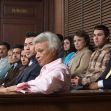Even though the trial judge failed to instruct jurors that a claim of imperfect self-defense was possible, an appeals court ruled that the omission was harmless error as it upheld the first-degree murder conviction of a stoned defendant who shot his friend in the head nine times, then set him on fire.
Writing for a unanimous three-judge panel, Associate Justice William J Murray, Jr. of the Third Appellate District of the Court of Appeal of the State of California affirmed the judgment of Judge Candace S. Heidelberger of the Superior Court of Nevada County in the murder trial of Jason Carl Schuller on November 10.
It took two juries to determine whether Schuller was sane or not during the sanity phase of the trial. His first jury could not decide, but a second jury found him sane. Schuller received a sentence of 25 years to life for the murder and another 25 years to life for a firearm enhancement.
At the trial, Schuller claimed self-defense, but his not guilty by reason of insanity plea was not persuasive. During his testimony, he claimed he was delusional and hallucinating at the time of the shooting. Defendant appealed, arguing that the trial court erred when it refused to instruct the jury that the lesser offense of voluntary manslaughter based on a claim of imperfect self-defense was available.
That defense, Schuller argued, is available if “substantial evidence demonstrated he had an actual, albeit unreasonable, belief in the need for self-defense that was not entirely delusional.” The appellate court agreed that the jury should have been instructed that the voluntary manslaughter was available. But ultimately, the appellate court wrote, the instruction error was harmless because the evidence was substantial and the availability of the lesser charge would not have made any difference.
Justice Murray recounted the events that took place on the night of the murder. The victim was referred to in the opinion as W.T. Both W.T.’s daughter and a neighbor heard banging sounds or gunshots. The neighbor saw defendant’s car speeding away, then saw smoke coming from W.T’s home. He went there, found W.T.’s body, put out the fire, and called 911. An hour-long car chase by a SWAT team and an armored car followed. When Schuller finally surrendered, a semi-automatic handgun was found in his car.
Back at the scene of the crime, police examined the body and found nine gunshot wounds, a gas can, blood spatter, a cell phone with a bullet hole, and a gas stove with the burners and oven on and at their highest settings. The neighbor also testified that W.T. had told him he did not want Schuller around.
At trial, defendant, his sister and the police all testified that Schuller was “experiencing delusions” for some time. He said he had been attacked with “Ninja stars,” but was shielded from harm by a “protective light” that was a gift from God. He claimed demons were trying to steal the light. But he also admitted that on the night of the murder he had consumed two or three beers and taken a “couple of hits of concentrated THC.” He said he shared the light with W.T., then took a shower, heard five gunshots and saw “a misty figure.”
Schuller also claimed that W.T. had “brought out a gun,” which was actually owned by defendant, who had asked the victim to store it for him. W.T, Schuller said, went into the kitchen, got a knife from a drawer, and tried, but failed, to stab him because a “white angel” was protecting him. Schuller asked W.T. if he was Lucifer, and he claimed, W.T. admitted he was. A scuffle ensued, and Schuller said that during it, he fired “just one shot” because he feared for his life when W.T. “came at him” with a knife.
After another argument and physical fight, defendant admitted shooting W.T. five additional times. He said he tried to call 911 but neither the house phone nor W.T.’s cell was working. He also said that he saw W.T.’s dentures fly out of his mouth, got scared, shot him five more times and shot the cell phone once. As he was leaving the house, he said, he saw a gas can and decided to use it to “kill the demon or Lucifer and send it to hell by setting the body on fire.” He then drove away.
During the trial, there was some discussion about whether the shooting was motivated by W.T.’s sexual advances. Schuller said he made that up because he thought “the gay thing would have been for justifiable for what happened.”
The prosecution rebutted Schuller’s version of events. One detective testified that his “normal” behavior changed after he decided to “pursue a mental health defense.” A psychologist testified that defendant was not mentally ill, but could have suffered from hallucinations because of his “extensive drug use.” Two forensic psychologists added that his actions after the shooting demonstrated that “he knew he did wrong.”
During the guilt phase of the trial, defendant asked for a jury instruction on voluntary manslaughter based on imperfect self-defense caused by Schuller’s extensive hallucinations about light and Lucifer. But the judge said the evidence at the crime scene did not match defendant’s version of events. Also, his self-defense claim was based on fear of harm from W.T.’s knife, but the knife was found on a table and not in the victim’s hand.
Murray then explained why the appellate court determined that Schuller had been entitled to an instruction on imperfect self-defense but concluded the “the error was harmless.” Citing several precedents about the criteria for a claim of imperfect self-defense, the court concluded that Schuller’s testimony “included evidence of delusion,” but his account “was not entirely (emphasis in original) delusional and thus provided substantial evidence of an actual but unreasonable belief in the need for self-defense.”
He might have thought W.T. was Lucifer, but he also testified that he shot W.T. because he “came at him with a knife.” In addition, there was physical evidence that disputed Schuller’s testimony. Based on these elements, Murray concluded, the jury should have received an instruction on imperfect self-defense because there was evidence that could have persuaded them either way. They could have found imperfect self-defense if they believed Schuller’s actual but unreasonable belief in the need for it. Yet they also could have rejected defendant’s testimony if they found it unreliable or unsupported.
Even though he concluded that the imperfect self-defense instruction should have been given, Murray then gave an explanation of the court’s finding of harmless error. He recounted defendant’s changing accounts of events that undercut his self-defense explanations. Added to these were his claims of hallucinations and delusions, his fire-setting, the lengthy car chase, his claims about faulty phones, and the mismatch between physical evidence and his account of the events on the tragic night.
The opinion ended with the words, “Given the evidence, we conclude there was no reasonable chance
of a more favorable outcome had the jury received the requested instruction.”






